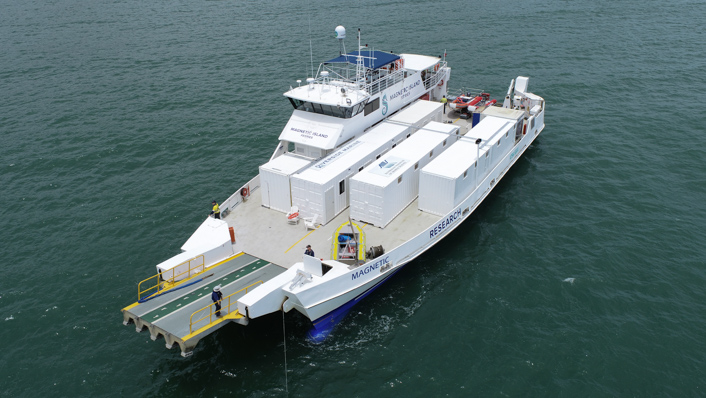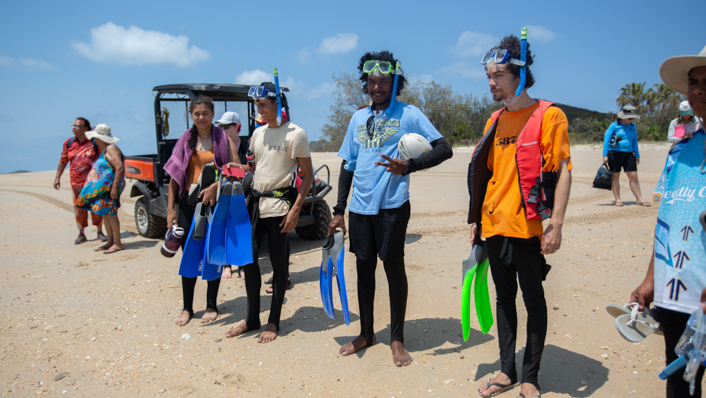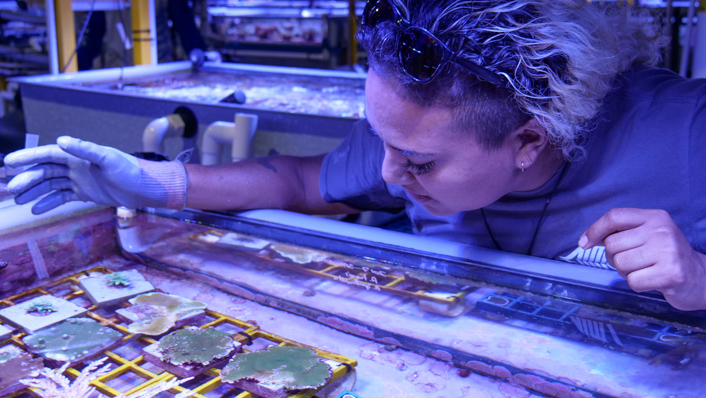The annual mass spawning of corals in the Great Barrier Reef is one of the most extraordinary natural phenomena on the planet. Scientists use this once-a-year opportunity to undertake valuable research needed to understand the early lives of coral.
AIMS scientists also investigate ways to enhance coral’s tolerance to warming oceans due to climate change and develop methods to scale up and fast-track coral recovery after disturbances.
This year, the Australian Coral Reef Resilience Initiative’s (ACRRI) Woppaburra Coral Project team took coral spawning out of the lab to on to sea Country. They gathered with Woppaburra Traditional Custodians to:
-
progress the science of coral seeding and
-
build skills and knowledge about spawning and coral seeding methods for the future.
Begun in 2019, the Woppaburra Coral Project is a partnership with Woppaburra Traditional Custodians. It is part of the Australian Coral Reef Resilience Initiative, a seven-year, AUD27 million research program, a partnership between AIMS and BHP.
From SeaSim to sea Country
Our science activities on coral fertilisation and rearing of young corals on the Great Barrier Reef are usually based in the AIMS National Sea Simulator.
In 2022, we did things differently.
The science team worked and lived on a floating lab – a car barge converted into a dedicated science platform – which allowed the team to answer questions about coral seeding processes on the sea.
Scientists and Traditional Custodians were joined by ACRRI partner BHP, international and national science collaborators, and participants from management and education.
Participants took a deep dive into reef renewal without getting wet by observing nocturnal coral spawning at the Konomie Environmental Education Centre. They also experienced a first-hand look at the science striving to fast-track reef recovery.
Over 40 people were involved. It was the largest single science and engagement field event in AIMS’ 50-year history.
Woppaburra sea Country – a time of renewal in a diverse marine ecosystem
This field event took place in Woppaburra sea Country, on and around Konomie (North Keppel Island), about 15km off the coast of Yeppoon on the southern Great Barrier Reef. This region hosts coral-fringed continental islands and is the sea Country of the Woppaburra Traditional Custodians.
Reefs here have been influenced by many disturbances over the years including marine heat waves causing mass coral bleaching, and cyclones. Many are in excellent health, but others are degraded and dominated by macroalgae. This makes the area a great place to investigate the barriers to reef recovery and to trial reef restoration techniques.
Reefs around the Keppel Islands are close to the coast. As such, coral spawning in this area generally occurs a month before reefs further offshore. The corals spawn across a handful of nights following the full moon.
Woppaburra Traditional Custodians back on Country
Woppaburra descendants have actively maintained cultural connections and responsibilities to land and sea country.
Woppaburra Traditional Custodians gained hands-on experience in marine science and coral seeding, building capabilities and empowering them to manage sea country in the future - from witnessing coral spawning, assisting with the collection of egg bundles, to collecting wild coral spawn.
Their experience included a community-driven coral aquaculture technique being used by the Moving Corals sub-program of the Reef Restoration and Adaption Program.
Innovative science for spawning on sea-Country
Coral reef restoration science is driven by the need to reverse declines in reef health due to the impacts of climate change. The science-driven restoration approaches aim to enhance resilience and to seed and accelerate natural adaptative processes.
The Woppaburra Coral Project (WCP) team researches and refines coral seeding - a restoration approach designed to seed corals to accelerate the return of coral cover to disturbed or damaged reefs. They are developing methods which use engineered devices to deliver young corals onto the reef, and investigating how this approach can be scaled to cover large areas. The team examines factors that influence the survival and growth of young corals, to reduce high mortality during their first year of life.
The science team spent November 2022 based on a floating lab undertaking projects and testing different methods for seeding, including ones which can only be achieved at sea.
Scientists collected parent coral colonies around the Keppel Islands area under permits, which spawned in aquaria on the vessel. For many projects, the resulting young corals were placed on local research sites in the area and monitored over the ensuing months.
International and national science collaborators joined the team in the field. The event also supported science for the Reef Restoration and Adaption Program, funded by the Australia Government's Reef Trust in partnership with the Great Barrier Reef Foundation.
Rearing coral babies in large tubs, or in floating nurseries - what are the pros and cons?
Coral seeding requires rearing free-swimming coral larvae in contained aquaculture facilities until they are ready to settle on the reef surface. Some methods use large enclose tubs, and others use floating cribs which allow the fertilised eggs to develop in the ocean corralled by a net under the surface.
This trip was the first time the methods were be tested side-by-side and directly compared to determine their pros and cons.
This study is in collaboration with SECORE International and tests the survival and genetic selection of both methods.
To the reef! A question of speed
Research to date indicates that young corals bred in aquaculture conditions have a higher rate of survival the quicker they are deployed into the wild. Bringing the lab to the reef helps test this to increase effectiveness, efficiency and cost for coral aquaculture.
The team and collaborators furthered investigations on methods to improve the survival of corals on engineered seeding devices, and ways to increase the heat resilience of corals bred in aquaculture.
Training the next generation of aquarists
Since 2021, Woppaburra Coral Project partners AIMS and BHP have supported two Indigenous-identified husbandry technicians to help build skills for the future.
To date, training has been based in AIMS' National Sea Simulator in Townsville. In 2022, training extended to spawning on sea Country to learn about facility maintenance, larval rearing, settlement and seeding methods.
Assistant technician Jamiga Cummins joined Woppaburra Traditional Custodians to share knowledge of marine life, coral spawning, and assist with training.
Sharing restoration science
Coral spawning on Woppaburra sea Country involved partners and participants from the following organisations:
-
AIMS, BHP and Woppaburra Traditional Custodians as partners in the Australian Coral Reef Resilience Initiative
-
The Reef Restoration and Adaptation Program, funded by the partnership between the Australian Government's Reef Trust and the Great Barrier Reef Foundation.









